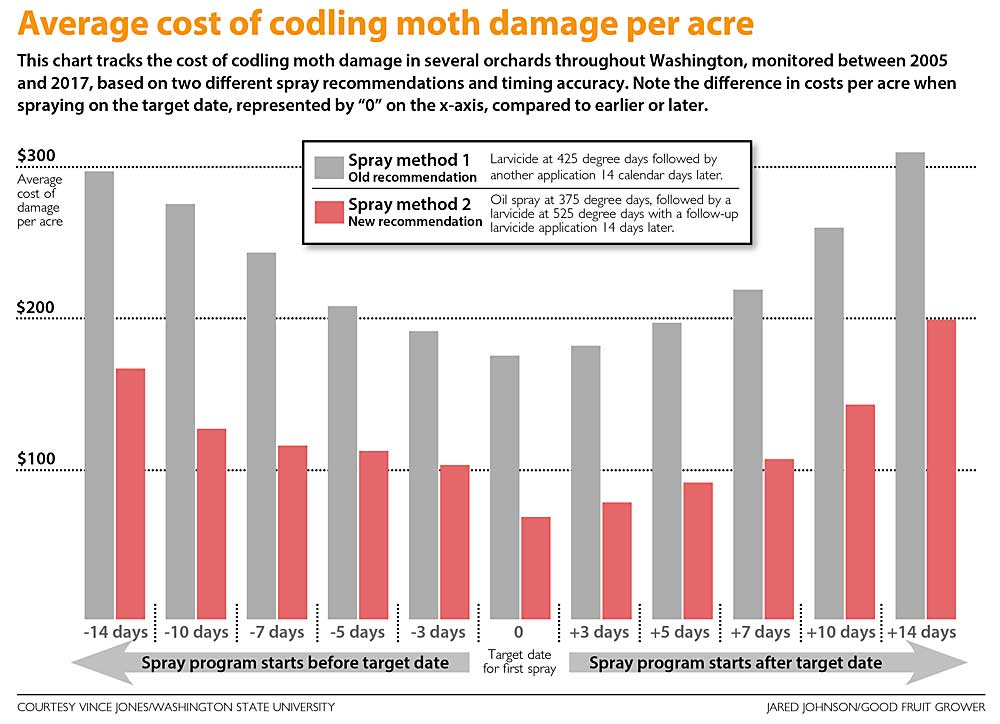
Timing is everything when it comes to codling moth.
That’s what Vince Jones, a Washington State University entomologist, wants to remind growers, many of whom have reported a resurgence of a pest often thought to be well controlled in Washington.
Most growers diligently do everything they can to control codling moth, but Jones wants to reiterate some tried and true methods anyway, especially when it comes to early season sprays following WSU’s online degree-day models. They work and should make codling moth relatively easy to control.
After several low-pressure years, growers may be tempted to save money and wait to take action until they see codling moths in traps. Traps indicate their presence but do not act as a gauge for treatment timing, Jones said. The pests can mate and cause damage before they show up in traps; they don’t fly as much in the early-season weather, and they aren’t evenly distributed within blocks. Sprays target the eggs or larvae, not the adults that wind up in traps.
Don’t ignore traps, he said. Place them ideally at a density of one per 2.5 acres, high in the canopy, but don’t rely on them for early-season spray timing.
Shortcuts have come back to bite the industry before, Jones said. In the early 2000s, he recalled, growers tried cutting back on the rates of mating disruption, to save money. “It was a disaster,” he said. However, once they bumped the rates back up, the problem went away.
Cutting corners works for maybe a year or two, but then the industry hits a hot year — like 2018 — and the population surges. That larger population then overwinters, making the following year even worse.
In December, at the Washington State Tree Fruit Association Annual Meeting in Wenatchee, Jones broke it down in terms of money. Between 2005 and 2017, several monitored orchards that sprayed on the exact recommended degree day suffered on average half or even less codling moth damage (measured in dollars) as those sprayed 14 days early or late.
Older recommendations called for the first application of larvicide at 425 degree days, followed by another round 14 calendar days later, because the chemicals have a residue of 14 calendar days. However, newer recommendations prescribe killing eggs with an oil spray at 375 degree days, then a larvicide at 525 degree days and a follow-up larvicide application 14 calendar days later.
Both work, though WSU favors the newer method. Either way though, mistiming execution adds up in costs, Jones said.
He encourages growers to use two online tools — the subscription-based Decision Aid System, or DAS, and the public pesticide record evaluator — to plan ahead and to measure where they went right or wrong in the past. Several growers will be testing a beta program that combines the two tools, as well as a long-range forecast, in a DAS offering. It may be released in 2021.
Some observers think climate change plays a role in surging codling moth damage. Increasingly variable spring weather makes poor timing an even bigger problem, Jones said. In the past, missing one day would cost about 15 degree days. Today, in warm years, that can be 25 degree days.
Whatever the reason for more codling moths, following all the recommendations year-to-year gives growers their best bet, Jones said.
“The bottom line to me is people need to go back to basics, make sure they are doing all they can to minimize the problems,” he said.
Find WSU’s predictive models for codling moth at decisionaid.systems and pesticides.decisionaid.systems
—by Ross Courtney
Related:
—Codling moth comeback
—Pests in the heat






Leave A Comment